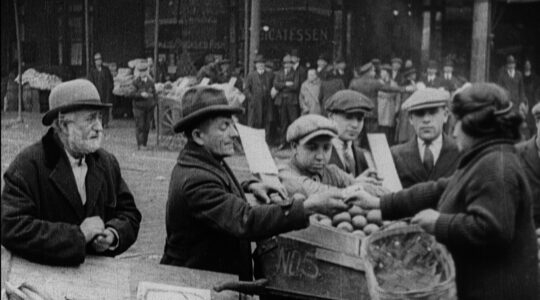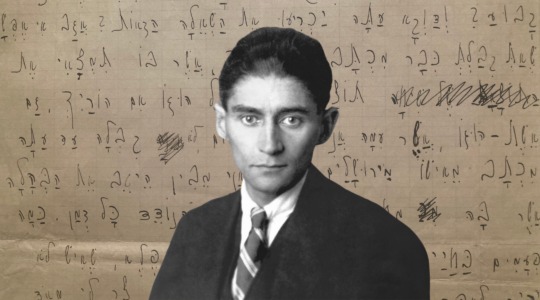Yeshiva University Museum has upped its cool — and its feminist — factor with a new exhibition showcasing comic art by Jewish women artists.
“Graphic Details: Confessional Comics by Jewish Women,” which opened last week, presents work by 18 artists from the U.S., Canada, England and Israel from the 1970s to the present.
The show, co-curated by London-based artist and academic Sarah Lightman and New York-based writer and comic-art collector Michael Kaminer, presents work combining the unapologetically intimate and traumatic, the hilarious and the profound.
What’s striking about “Graphic Details” is that women characters are always center stage in the comic art presented — countering traditional comic art by male artists in which women were (and still are) presented as sexual objects.
Women are the ones who objectify themselves in “Graphic Details,” telling their own tales of relationships, family, sex, body issues, pregnancy, as well as their relationship with Judaism, Israel and community, using their own comic alter-egos.
There is a particularly politicized statement in work shown by underground comic art pioneers from the 1970s and 1980s, such as Trina Robbins, Aline Kominsky-Crumb and Diane Noomin, who created the Wimmin’s Comix and Twisted Sisters anthologies.
“The 1970s work took place in a more politicized context; these women were reacting to horrible sexism in the underground comics world,” explains Michael Kaminer about his and Lightman’s curatorial choices. “By exposing themselves the way they did, those artists made an enormous impact on comics and the culture at large. Much of the work of today is no less bold or gripping, but takes place in an environment somewhat less charged with gender politics.”
Says Hungarian-born artist Miriam Katin, whose cartoon “Eucalyptus Nights” (2005), is featured in the exhibition: “These women artists fought the war to be recognized, and I respect them.”
Graphic storytelling is at times a form of catharsis for the artists, a way to confront trauma and expel painful feelings. In “Baby Talk: A Tale of Four Miscarriages” (1995), Diane Noomin deals with the pain of repeated pregnancy loss and infertility. In a multilayered story within a story, Noomin’s fictional self battles with her comic alter-ego Didi Glitz about the best way to tell the sorry tale:
“Didi, I can’t tell the story without using Glenda and Jimmy as stand-ins!!”
“It’s your story … are you gonna let some cartoon yuppies cry cartoon tears over your lost babies?”
Somehow, even when depicting moments of great sorrow, Noomin uses humor as her way of coping.
“The slow process of building up an image helps heal me from the angst of any story I am telling,” says Lightman, whose art is presented in the exhibition. “I wanted to show something beautiful coming out of something that hurt.” Her penciled drawings in “Dumped before Valentine’s Day” (2007) tell the poignant story of receiving the dreaded breakup call from a boyfriend as she sits alone on a bench.
Humor, often self-deprecating, is a reflex for many of the artists. Lauren Weinstein — whose multicolored painted cartoons contrast the black-and-white or pencil favored by many other creators in the show — recounts tales of her hilariously awkward teenage self in “This is the book of Lauren Weinstein” (2009). She recounts going to the prom, her dysfunctional family life, her interactions with her equally awkward peers, all the while casting an adolescent’s unforgiving gaze on her flawed body.
Some artists are also unapologetically crass and embrace scatological or smutty humor with relish. Miss (her real first name) Lasko-Gross’ “The Turd” (2009) is a hilarious tale of a woman’s crisis in a Starbucks bathroom when her excrement refuses to flush.
From unflushable feces to jokes as a way of confronting trauma, humor is definitely central to “Graphic Details.”
“When you’re dealing with personal issues, memories or traumas, humor is an effective way to confront them. Isn’t that how Jews have managed all these millennia?” says Kaminer.
What is it about the comic medium that attracts these artists?
“I realized through this method I can tell the stories I carried with me all my life. They somehow begged to be told,” says Katin. Her sepia-tinted “Eucalyptus Nights” tells a story from her time serving in the Israel Defense Forces in the 1960s; the experience involved a seedy encounter between soldiers and prostitutes, with a subplot showing the failure of a “cross-cultural” relationship between an Ashkenazi soldier (Katin herself?) and her Sephardic soldier boyfriend.
Jewish identity and Israel are certainly recurring themes in “Graphic Details,” although not all the artists necessarily create “Jewish art.” Some artists such as Ariel Schrag or Weinstein deal with issues surrounding Jewish identity: being half-Jewish in Schrag’s case or intermarriage in Weinstein’s. In her gently self-mocking “The Chosen” (2008), Schrag tells the tale of pretending to her chasidic property broker that she is authentically Jewish, although she is keenly aware that if he knew she is only Jewish through her father, not her mother, he would not accept her as part of the Tribe. “My whole body tingled with the narcotic feeling of belonging.”
There is also a wider feminist mission for gathering works by these women comic artists. “A central agenda of the show is the creation of an archive about these artists; I am committed to the act of ensuring that art history is written about women comic artists,” says Lightman. “It’s a feminist agenda — art history has in the past been written about male artists and defined by the work the men produce, excluding women. That is now changing.”
“Graphic Details: Confessional Comics by Jewish Women” is on view at Yeshiva University Museum, 15 W. 16th St. (212) 294-8335. The show runs through April 15.
The New York Jewish Week brings you the stories behind the headlines, keeping you connected to Jewish life in New York. Help sustain the reporting you trust by donating today.




